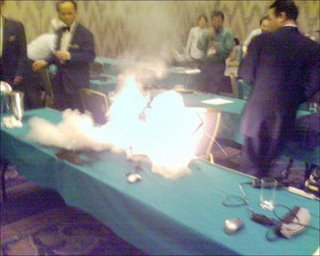Physicists seek to put one thing in two places
Sounds Quizzy isn't it.. But seems to be quite intresting invention to watch... and move objects :-)
Physicists say they have made an object move just by watching it. This is inspiring them to a still bolder project: putting a small, ordinary thing into two places at once.
It may be a “fantasy,” admits Keith Schwab of Cornell University in Ithaca, N.Y., one of the researchers. Then again, the first effect seemed that way not long ago, and the second is related.
| |
The gray sliver reaching from top to bottom, slanted in the image, is a nanomechanical resonator, a sub-microscopic device that can vibrate like a piano string. The image was taken with a scanning electron microscope and colorized. (Courtesy Cornell University) |
The research comes from the edge of quantum mechanics, the submicroscopic realm of fundamental particles. There, things behave with total disregard for our common sense.
They can show signs of being in two places at once; of being both waves and particles; of taking on some characteristics only at the moment these are measured; and of acting synchronously while far apart, with no apparent way to communicate.
Although these tiny building blocks of our universe do this, the relatively huge things we see every day don’t. The uncanny behavior fades the bigger a thing becomes.
This is because when quantum entities are combined to make ordinary objects, the rules governing each component’s behavior add up to produce new rules. These increasingly resemble the laws of our familiar reality as more additions take place.
But just how big can something be and still show signs of slipping back into its quantum-mechanical nature?
Schwab and his colleagues decided to find out. In work described in the Sept. 14 issue of the research journal Nature, they built a device colossal by quantum standards: about nine thousandths of a millimeter long, containing some 10 trillion atoms.
The object was a sliver of aluminum and a type of ceramic, fixed at both ends but free to vibrate like a guitar string in between. To measure its movements, the scientists set nearby a tiny detector called a superconducting single electron transistor.
They found that random motions of charge-carrying particles, electrons, in the detector emanated forces that affected the metallic sliver. When the detector was tuned for maximum sensitivity, these forces slowed down the sliver’s shaking, cooling it as a result. This effect, Schwab said, is a basically quantum-mechanical phenomenon called back-action, in which the act of observing something actually gives it a nudge.
Back-action in quantum mechanics also makes it impossible to know a particle’s exact location and speed simultaneously. This limitation is called the uncertainty principle. A common example: measuring place and speed requires some detector that can “see” the particle. But this involves bouncing a light wave off it, which gives it a random push.
“We made measurements of position that are so intense—so strongly coupled—that by looking at it we can make it move,” said Schwab. Normally, such motion wouldn’t cool an object. But the motion can be such as to oppose ongoing movements and slow them down. This reduces an object’s heat, which is just the jiggling of particles in it.
If back-action applies such a large item, Schwab reasons, maybe that can also be true of other quantum-mechanical rules. Particularly intriguing, he said, is the superposition principle, which holds that a particle can be in two places at once.
A classic example is the shooting of light particles, called photons, through two slits in a barrier. Past the slits, they will behave as if they were waves. This alone is no surprise: it’s a well-known quantum mechanical phenomenon that particles can paradoxically act like waves in some situations. The photons’ waviness then makes them “interfere” with each other. In other words, they make patterns like those seen when you toss two pebbles in a pond, and the ripples they make overlap.
When the waves passing the two slits mutually interfere, the pattern becomes visible if you set up another wall where the photons can land. There, alternating bright and dark stripes appear.
But bizarrely, this works even if you fire just one photon at a time through the slits. You can see the effect then by putting photographic film on the landing wall, so each photon leaves a lasting mark. Keep firing photons, and the marks gradually add up to make the stripes again.
It’s as if each photon is interfering with itself—that is, going through both slits simultaneously. This also works for bigger particles, up to a point. But what point? Schwab wants to know. “We’re trying to make a mechanical device be in two places at one time. What’s really neat is it looks like we should be able to do it,” he said. “The hope, the dream, the fantasy is that we get that superposition and start making bigger devices and find the breakdown.”
In a commentary in the same issue of Nature, Michael Roukes of the California Institute of Technology in Pasadena, Calif., wrote that Schwab’s work with the cooling is part of an emerging field, quantum electromechanics. This, he added, focuses on submicroscopic devices called nanomechanical systems, “poised midway between two seemingly antithetic domains” of size: fundamental particles at one end, the objects of everyday life at the other.








